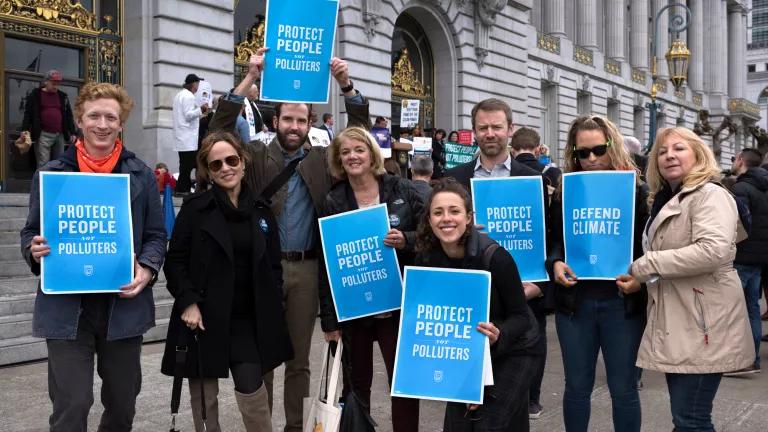China’s President Commits to Enhance Climate Action

During his speech to the UN General Assembly today, Chinese President Xi Jinping announced that the country will enhance its climate change ambitions. This announcement is the starting bell on the next critical leg of the race for the world—especially all major climate polluters—to significantly strengthen their climate actions in the next year. President Xi said that China will scale-up its nationally determined contribution (NDC) under the Paris Agreement by peaking CO2 emissions before 2030 and adopting more vigorous policies. He also announced an aim for China to achieve carbon neutrality before 2060.
The Chinese President’s announcement is an initial sign that the country is committed to low-carbon development as the best recovery strategy from economic disruptions due to COVID-19. China’s ambition shows how countries can simultaneously prioritize revitalizing their economies and protecting the climate. This builds on the push from the European Union (EU) with the European Commission proposing to strengthen its climate targets to cut emissions 55 percent below 1990 levels by 2030—a significant strengthening from their original target of at least a 40 percent cut under the Paris Agreement.
Working with the NewClimate Institute, NRDC analyzed the emissions cuts that would be possible if various countries, sectors, and others mobilized even greater action before 2030. We found that China’s enhanced climate targets could play a major role in helping to “close the emissions gap” by 2030 (see figure).
An earlier CO2 peak could help cut global emissions. China should seize the opportunity to meaningfully enhance its NDC to the Paris Agreement. During a joint announcement with President Obama in 2014, China committed to peak CO2 emissions around 2030. Through peaking CO2 emissions in 2025 by capping coal consumption by 2020, China could cut emissions by at least 2.5 billion tons per year by 2030. China is already on the way to meeting this action, having cut its coal consumption by 9.4 percent from 2013-16, implemented a target to reduce the share of coal in total energy consumption from 64 percent in 2015 to 58 percent by 2020, and led the world in installing wind and solar power.
Are bigger emissions cut in the cards? If China were to act even more aggressively it could make a bigger dent in global emissions. By peaking its CO2 emissions in 2025 and reducing them back down to 2020 levels by 2030, China could make an even more significant contribution to cutting global greenhouse gas emissions. For example, if China were also to implement a strong cap to peak oil consumption by 2030 at levels not significantly greater than current annual consumption, it would result in an additional reduction of 0.4 Gt CO2 equivalent per year by 2030. Both capping coal consumption and peaking oil consumption China could cut global emissions by at least 2.9 billion tons per year by 2030.
China’s NDC could also commit to put a cap on not just its CO2 emissions but also its significant and growing non-CO2 emissions. China’s implementation of strong policies with concrete targets to reduce non-CO2 greenhouse gases using technically feasible measures could close the emissions gap by an additional 0.7 Gt of CO2 equivalent annually by 2030. The combination of these non-CO2 cuts with aggressive CO2 cuts (as described above) could together cut global emissions by 3.6 billion tons per year by 2030.
Given changes in China’s economy, it is likely to already be on a trajectory to peak CO2 emissions around 2025. Therefore, strong additional measures will need to be taken in order to significantly decrease its emissions. The Chinese government’s upcoming 14th Five-Year Plan is an important opportunity to detail the roadmap for ambitious and concrete actions from 2021-2025 to deliver on the high-level signals communicated today.
Long-term target sends an unambiguous signal of downward emissions reductions. China had not previously committed a long-term target to achieve carbon neutrality. President Xi’s aim to achieve carbon neutrality before 2060 is encouraging as it sets a clear signal to orient the Chinese and global economy toward a low-carbon future. The Intergovernmental Panel on Climate Change (IPCC) tells us that in order to have a good chance of keeping global warming below 1.5 degrees, global emissions should reach net zero by 2050. Therefore, all major emitters need to play a responsible role in setting a clear trajectory to net zero emissions by 2050, if not before.
Starting bell on the sprint to stronger climate action begins. Under the Paris Agreement on climate change, all countries—especially the biggest polluters like China, the US, and the EU—are expected to enhance their national targets before a major climate summit in the UK next November. China and the EU have raced off the block quickly, and we anticipate elaboration of more detailed action from these countries and others joining the race.





